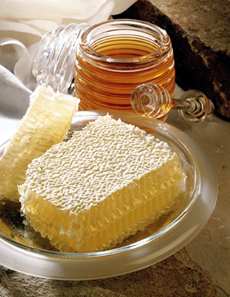

A honey comb and a jar of liquid honey. Bees construct honeycombs to protect their larvae and store their pollen and honey. The com is made from beeswax secreted by worker bees, who chew and mold the wax into six-sided sells that together form a honeycomb 2-4 feet long. Empty the comb weighs just a few ounces, but when full of honey it can weigh many pounds. The comb is edible, although most people prefer eating honey after it has been drained from the comb. Photo courtesy of National Honey Board.
February 2005
Updated February 2008
|
 |
Storing & Using Honey
Getting The Most From Your Fine Honeys
How should you store your honey? Several of these tips are courtesy of the National Honey Board. Visit their website, Honey.com, for a whole hive-full of honey information.
Storage
 |
Store honey at room temperature. Your pantry shelf is ideal, or kitchen counter away from direct sunlight. Like most foodstuffs, honey likes a location that is cool and dry.
|
 |
Storing honey in the refrigerator accelerates the honey’s crystallization. Crystallization is the natural process in which liquid in honey becomes solid.
- If your honey crystallizes, simply place the honey jar in hot water and stir occasionally until the crystals dissolve (10 to 15 minutes). Or, place the honey in a microwave-safe container with the lid off and microwave it for 30 seconds.
- Honey does not spoil, because of its high sugar and moisture concentration. Edible honey has been found in the tombs of the Pharaohs!
|
Cooking Tips
 |
For easy measuring and clean-up, coat the measuring cup or spoon with cooking spray before adding honey.
|
 |
A 12-ounce jar of honey equals a standard measuring cup.
|
 |
For best results, use recipes developed for using honey. Honey is sweeter than sugar: they are not substitutes for each other.
- When you substitute honey for granulated sugar in recipes, begin by substituting honey for up to half of the sugar called for in the recipe. With experimentation, honey can be substituted for all the sugar in some recipes.
|
 |
Honey enhances the color of crusts, and imparts its rich, distinctive flavor to all baked goods—breads, muffins, cookies, cakes and pies. It also is a natural moisturizing agent, keeping cakes moister longer. When substituting honey for sugar in baking:
- Reduce the liquid in the recipe by 1/4 cup for each cup of honey used.
- Add about 1/2 teaspoon baking soda for each cup of honey used.
- Reduce oven temperature by 25 degrees to prevent over-browning.
- A slightly different rule of thumb: substitute honey for up to half of the sugar called for in the recipe, but for every 12 ounces of honey added, reduce the amount of liquid required by three ounces.
This is why it often makes sense to get a honey cookbook or find recipes where others have already worked out the measurements! Especially look for Greek and Italian recipes that incorporate honey with fresh herbs like basil, sage and thyme—they’re exquisite. They generally use olive oil as well, but are so buttery you would never know.
|
 |
It’s also important to match the varietal to the recipe.
- Lighter-flavor honeys are more general purpose and can be used for baking, sweetening, desserts, and candy. Examples include alfalfa, clover and orange blossom.
- Medium-intensity honeys with good varietal character will show through in seasoning. Examples are eucalyptus, lavender, sage, thyme and tupelo. Use them in ice cream, sauces, marinades and salad dressings.
- Stronger honeys should be used for earthy or savory dishes requiring a stronger flavor, or sweet dishes that make a statement. Buckwheat and chestnut honeys, for example, can be used in sauces and marinades for meats; in cookies, rich and muffins with deeper flavors; in ice cream; with stronger cheeses.
- See our food, beverage and varietal honey pairing chart.
|
Infusing Honey
 |
It is possible to infuse your own honey with culinary lavender, orange peel and other flavors. In order to avoid mold, Ted Dennard of Savannah Bee Company suggests a honey with thicker viscosity, which means less moisture (mold grows in moisture). Some honeys can be 15% moisture and are remarkably more viscous than than a 17% moisture honey. Unfortunately, this information isn’t on the label, so you’ll have to try different honeys and choose the thickest one. Be sure all the pith is off any citrus rind, since the pith also contains moisture. Finally, make sure that any inclusions are below the surface of the honey, so they are not exposed to air.
|
Note: Honey should not be fed to infants under one year of age. Honey is a safe and wholesome food for older children and adults.
National Honey Board
390 Lashley Street / Longmont, CO 80501 / www.honey.com
© National Honey Board. Images are copyright of their respective owners.
|




